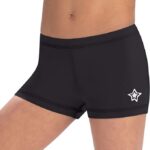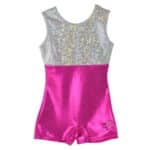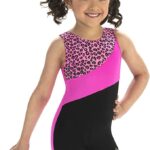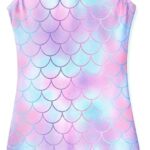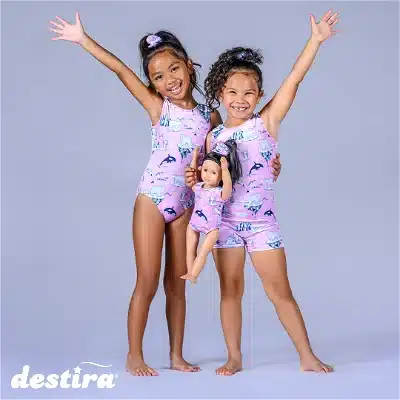
When it comes to gymnastics, dance, or any athletic activity that requires flexibility and movement, having the right clothing is essential. The main options fall between a leotard v unitard v biketard. In this article, we’ll take a closer look at each of these garments, their differences, as well as their benefits and drawbacks.
Table of Contents
At a glance
Check out our quick reference table to spot the differences and similarities between a leotard, unitard and biketard.
| Leotard | Unitard | Biketard | |
| Torso Coverage | Complete | Complete | Complete |
| Sleeve Type(s) | Long or Short | Long or Short | Short |
| Leg Coverage | None | Usually to ankles | Usually to mid-thigh |
| Practice or competition wear? | Both | Practice | Practice |
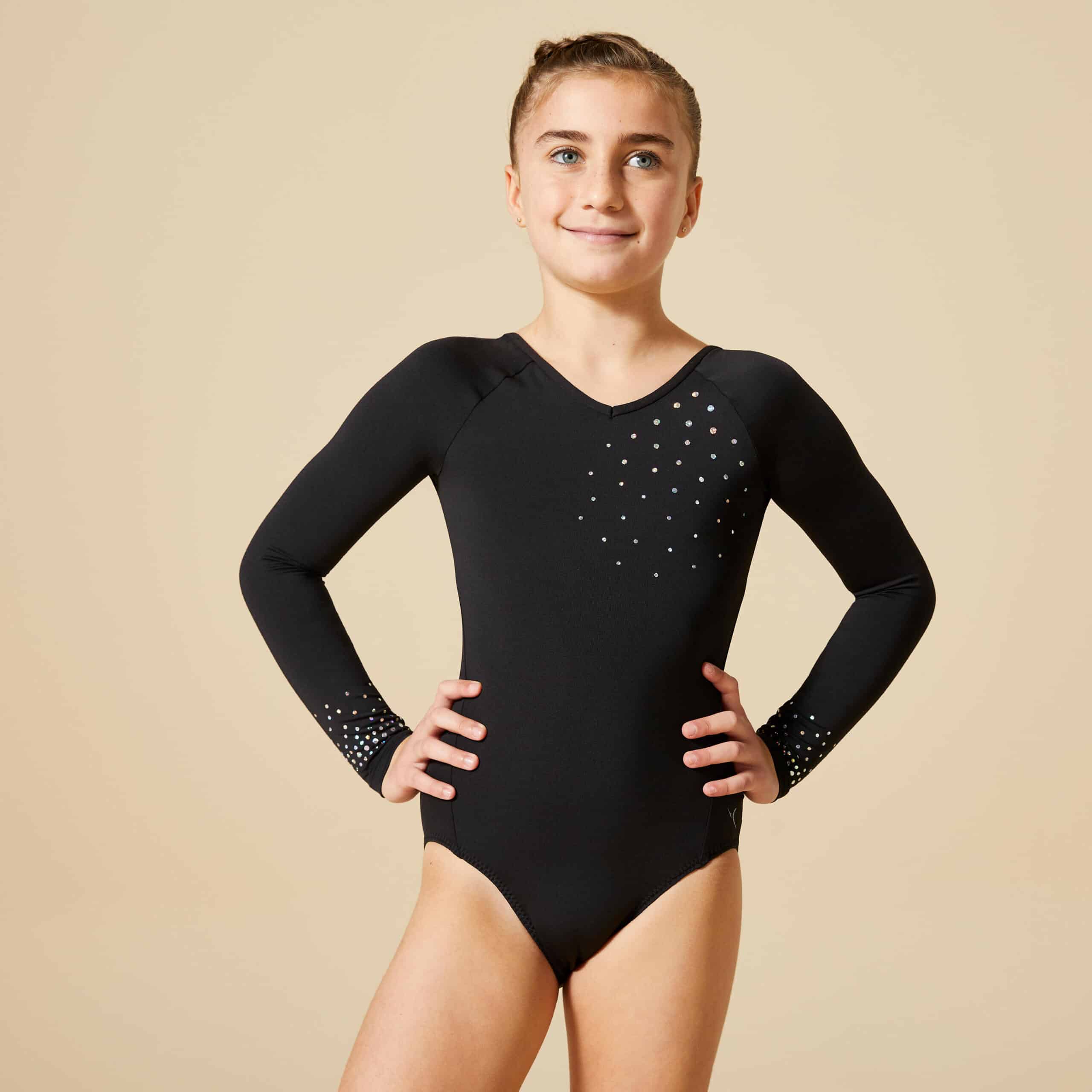 |  |  |
Before we get into this, I should point out that the term Unitard and Biketard are used interchangeably by some brands which makes it a little trickier! And on that note, Unitards are also called bodysuits by some people. Each is designed with the same purpose in mind: to give a maximum range of motion and comfort when performing gymnastics, dance and other similar sports. Hopefully, by the end of this article, all the definitions will become clear!
What is a Leotard?
A leotard is a one-piece garment that covers the torso but leaves the arms and legs exposed, though long-sleeved leotards are increasingly popular nowadays. It’s named after the French acrobat Jules Leotard, who first popularized the garment in the late 1800s.
Originally made of wool, leotards are now commonly made of spandex or lycra, which allows for greater flexibility and movement. They come in a variety of styles, including tank, short-sleeved, and long-sleeved, and can have a high or low-cut leg.
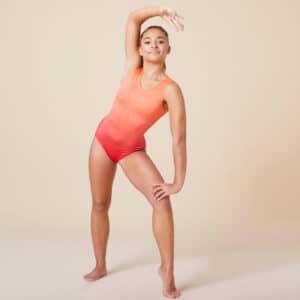
Can You Wear Leotards for Gymnastics?
Yes, leotards are a popular choice for gymnastics due to their flexibility and range of motion. They allow athletes to move freely without restriction, which is essential for executing complex maneuvers.
Male gymnasts always wear shorts with a leotard but for females, shorts are optional.
Benefits and Drawbacks
One of the main benefits of leotards is their flexibility, which allows for a greater range of motion. They’re also easy to move in and don’t ride up or shift during activity. However, they can be revealing, and some people may feel self-conscious wearing them. Additionally, they don’t provide as much coverage or protection as other garments, which may be a concern for some athletes.
Best Brands
Some popular leotard brands include GK Elite, Destira, and Obersee.
Check out my in-depth review of the best leotards for gymnastics here.
What is a Unitard?
A unitard is a one-piece garment that covers the entire body, including the arms and legs. It’s similar to a leotard but provides more coverage. Unitards are typically made of spandex or lycra and come in a variety of styles, including tank, short-sleeved, and long-sleeved, and can have a high or low-cut leg.

Can You Wear a Unitard for Gymnastics?
Yes, unitards are a popular choice for gymnastics as they provide more coverage and protection than leotards while still allowing for a full range of motion. They are especially popular with younger gymnasts at practice. They are not normally worn at gymnastics competitions.
Benefits and Drawbacks
One of the main benefits of unitards is the additional coverage and protection they provide compared to leotards. They can also be more comfortable for some people as they provide full-body coverage. However, they may be less flexible than leotards and can be more difficult to move in, especially for more complex maneuvers.
Best Brands
Some popular unitard brands include GK Elite, Destira, and Motionwear.
What is a Biketard?
A biketard is a one-piece garment that covers the torso, arms, and legs, similar to a unitard, but with shorts instead of full-length legs. Biketards are often worn for cycling or bike racing (hence the name), but can also be worn for other athletic activities like gymnastics.
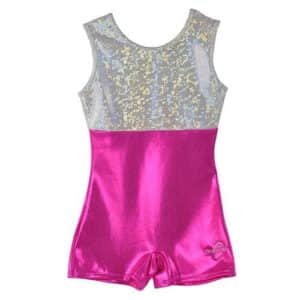
Can You Wear Biketards for Gymnastics?
Yes, biketards are a popular choice for gymnastics as they provide more coverage and protection than leotards, but with the added benefit of shorts instead of full-length legs, which can be more comfortable and less restrictive. Biketards are similar to Unitards in that they are common at gymnastics practice but are not usually worn at competitions.
Benefits and Drawbacks
One of the main benefits of biketards is the additional coverage and protection they provide compared to leotards, while still allowing for a full range of motion. The shorts also provide more coverage and can be more comfortable than full-length legs. However, biketards may not be as flexible as leotards or unitards, which may be a drawback for some athletes. Additionally, biketards may not be as widely available as leotards or unitards, making it more difficult to find the right fit and style.
Best Brands
Many of the big leotard brands also sell Biketards (though some refer to Biketards as Unitards). Big brands include GK Elite, Obersee and Decathlon.
Check out my review on the best Biketards here.
Conclusion
In conclusion, when it comes to athletic activities that require flexibility and movement, having the right clothing can make all the difference. The garments in this article are all popular options that offer varying levels of coverage and protection.
Ultimately, the choice between a leotard v unitard v biketard will depend on personal preference and the specific activity being performed. Regardless of which garment is chosen, investing in high-quality brands like GK Elite, or Destira can ensure optimal performance and comfort.
- Best Gymnastics Shorts (reviewed)The best gymnastics shorts are designed to be worn over the top of a leotard providing additional coverage around the upper legs, whilst allowing gymnasts… Read more: Best Gymnastics Shorts (reviewed)
- Why do Gymnasts Wear Leotards? (explained)Discover the reasons why gymnasts wear leotards in this informative article. From providing maximum flexibility and range of motion to allowing judges to easily assess… Read more: Why do Gymnasts Wear Leotards? (explained)
- The Interesting History of Gymnastics LeotardsGymnastics is a sport that has been around for centuries. With its roots tracing back to ancient Greece, gymnastics has come a long way since… Read more: The Interesting History of Gymnastics Leotards
- Leotard v Unitard v BiketardWhen it comes to gymnastics, dance, or any athletic activity that requires flexibility and movement, having the right clothing is essential. The main options fall… Read more: Leotard v Unitard v Biketard
- The Best Gymnastics BiketardsGymnastics biketards are a great alternative to wearing a leotard and shorts for practice. They not only provide comfort and additional coverage but also allow… Read more: The Best Gymnastics Biketards
- The Best Unitards for GymnasticsUnitards (also known as Biketards) are an excellent alternative to leotards for young gymnasts. A proper gymnastics unitard allows freedom of movement and provides coverage… Read more: The Best Unitards for Gymnastics

